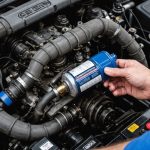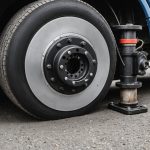Understanding ABS and its Importance for GSX-R1000
An Anti-lock Braking System (ABS) is crucial for enhancing motorcycle safety, acting as a pivotal safety feature that prevents wheel lock-up during braking. This functionality is particularly vital when riding the GSX-R1000, ensuring that the motorcycle maintains stability even on slippery surfaces or during sudden stops.
ABS functionality significantly improves braking performance by modulating brake pressure. Instead of a full lock-up, ABS momentarily reduces pressure, allowing the wheel to continue rotating. This rotation helps riders maintain control and steerability, which is essential during critical situations. This enhanced handling can mean the difference between a safe stop and a skid.
In the same genre : Essential Steps for Inspecting and Changing Brake Fluid on Your Honda Africa Twin: A Comprehensive Guide
For riders, it is essential to understand how braking performance varies with ABS. Novice riders should feel assured that ABS aids in developing confidence on the road. Meanwhile, experienced riders can tweak settings to match their style, environment, and needs, thus optimizing safety without compromising on performance. Proper adjustment is crucial; neglecting it could lead to inadequate response during emergencies. In essence, for both novice and seasoned riders, maintaining the right ABS setting ensures optimal safety and enhances the motorcycle’s overall performance.
ABS Adjustment Basics
Understanding the nuances of ABS settings is key to optimizing performance. With the right adjustment techniques, you can maximize the efficiency of your ABS system. Different scenarios require tailored settings to ensure the system operates to its full potential.
Additional reading : Essential Guide: Key Steps to Properly Maintain the Drive Chain of Your Ducati Scrambler 800
Introduction to ABS Settings
To begin, it’s important to grasp the purpose of ABS settings. Anti-lock Braking Systems (ABS) are designed to prevent wheel lock-ups during sudden stops. Adjusting the settings allows for a customizable response, enhancing your vehicle’s safety and handling in various conditions.
Common Terms and Concepts
Familiarity with common terms and concepts can demystify the adjustment process. You’ll frequently encounter terms like “brake modulation,” referring to the ABS system’s ability to modulate hydraulic pressure effectively. Another important concept is “wheel slip,” which measures how much a wheel is rotating relative to the vehicle’s speed.
Basic Tools Required for Adjustment
To perform ABS adjustments, several tools are essential. These include:
- Diagnostic scanner for reading and resetting fault codes
- Torque wrench for precise adjustments
- Basic hand tools
Proper understanding and usage of these tools allow for effective evaluation and fine-tuning of your current ABS settings, ensuring optimal performance.
Step-by-Step ABS Adjustment Process
A step-by-step guide to adjusting ABS on the GSX-R1000 can greatly enhance your ride, balancing comfort with performance. Here’s how:
First, locate the ABS control module on your GSX-R1000. It’s usually accessible via the bike’s dashboard. Configure your settings through the bike’s user interface by navigating to the ABS options.
To start the adjustment, experiment with different settings to understand how each affects your bike’s braking dynamics. A lower ABS sensitivity might enhance your control during aggressive riding, but reduce comfort as the braking feels more abrupt. Conversely, higher sensitivity may offer smoother braking, perfect for casual rides.
Consider your usual riding environment. For urban landscapes with frequent stops, prioritize comfort – a balanced set-up with moderate ABS intervention might prove beneficial. However, for spirited rides on winding roads, tuning ABS for performance will enhance your overall confidence and enjoyment.
Adjust incrementally and test ride after each setting change to feel how various adjustments influence your riding dynamics. With patience, you can achieve a harmonious balance between comfortable cruising and precise performance, tailored to your specific preferences and needs.
Monitoring and Tracking Changes
Monitoring performance adjustments is crucial for ensuring optimal results. It allows you to understand what works, what doesn’t, and where improvements can be made.
Importance of Tracking Adjustments
Consistently tracking adjustments in ABS settings is imperative. This practice enables you to pinpoint how specific changes influence the overall efficiency and safety of the bike. By maintaining accurate records, you can draw precise connections between adjustments and performance outcomes.
Recommended Methods for Monitoring Performance
Adopting systematic methods for monitoring can significantly enhance performance review processes. Utilize digital tools to log changes and gather data. Employing telemetric systems can offer insights into speed, braking efficiency, and response times. These technologies are invaluable in understanding the direct impact of ABS adjustments.
Utilizing Rider Feedback
Rider feedback serves as an essential component of the performance analysis process. By engaging riders in open discussions, you can harness their real-world experiences to fine-tune ABS settings.
- Techniques such as surveys and feedback forms can be employed.
- Digital dashboards for real-time feedback integration provide nuanced insights into rider preferences.
- Collecting this data aids in crafting ABS systems that align with rider expectations and safety requirements.
Troubleshooting Common ABS Issues
Identifying common ABS problems is the first step in ensuring your braking system functions properly. Problems such as unusual noises, warning lights on your dashboard, or unexpected behavior during braking can indicate ABS issues. These issues may affect your vehicle’s performance, leading to extended stopping distances or the ABS failing to engage when needed.
Step-by-Step Troubleshooting Guide
To address these problems effectively, follow this troubleshooting guide:
-
Check the ABS Warning Light: If illuminated, it may suggest a faulty sensor or wiring issue.
-
Inspect Brake Fluid Levels: Low brake fluid can trigger ABS alerts. Ensure levels are adequate, and there are no leaks.
-
Examine ABS Sensors and Wiring: Look for any signs of damage or disconnection. A damaged sensor can result in incorrect ABS activation.
-
Review the ABS Module: Corroded or faulty modules could hinder performance.
Preventive Maintenance Tips
Regular maintenance helps prevent ABS problems. Consider these tips:
- Schedule periodic brake inspections.
- Replace brake fluid every 1-2 years.
- Routinely monitor the condition of wires and sensors.
Following these steps ensures your ABS remains in excellent condition, providing reliable braking performance.
Expert Insights and Tips
Enhancements tailored to the GSX-R1000 can genuinely transform a riding experience. Riders often seek expert advice for these modifications, focusing on performance and safety. Performance testing is crucial in this context, providing valuable data to ensure that any adjustments made deliver the desired improvements without compromising safety.
Advice from Experienced Riders
Experienced riders frequently suggest starting with minor tweaks to the ABS settings of the GSX-R1000. Understanding how the system reacts in different conditions is essential. Adjustments should initially be tested in controlled environments to gauge impact accurately.
Real-World Examples of Adjustments
Rider enhancements are best illustrated through real-life examples. One rider improved their track times significantly by altering the suspension settings in conjunction with the ABS. This adjustment translated to smoother cornering and efficient braking, showcasing how tailored modifications can lead to better overall performance.
Additional Resources and Guides
To maximize effectiveness, consider consulting additional resources. There are numerous online forums and guides authored by seasoned GSX-R1000 enthusiasts. These platforms often feature case studies and step-by-step methodologies on ABS adjustments, providing practical insights for making educated changes. Exploring these can deepen understanding and confidence in implementing enhancements.











